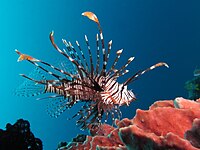
Photo from wikipedia
Sticklebacks (Gasterosteiformes) are increasingly used in ecological and evolutionary research and have become well established as role model species for biologists. However, ecotoxicology studies concerning behavioural effects in sticklebacks regarding… Click to show full abstract
Sticklebacks (Gasterosteiformes) are increasingly used in ecological and evolutionary research and have become well established as role model species for biologists. However, ecotoxicology studies concerning behavioural effects in sticklebacks regarding stress responses, mainly induced by chemical mixtures, have hardly been addressed. For this purpose, we investigated the swimming behaviour (including mortality rate based on 96-h LC50 values) of two ecologically similar three-spined (Gasterosteus aculeatus) and nine-spined sticklebacks (Pungitius pungitius) to short-term (up to 24 h) metal mixture (MIX) exposure. We evaluated the relevance and efficacy of behavioural responses of test species in the early toxicity assessment of chemical mixtures. Fish exposed to six (Zn, Pb, Cd, Cu, Ni, and Cr) metals in the mixture were either singled out by the Water Framework Directive as priority or as relevant substances in surface water, which was prepared according to the environmental quality standards (EQSs) of these metals set for inland waters in the European Union (EU) (Directive 2013/39/EU). The performed behavioural analysis showed the main effect on the interaction between time, species, and treatment variables. Although both species exposed to MIX revealed a decreasing tendency in swimming activity, these species’ responsiveness to MIX was somewhat different. Substantial changes in the activity of G. aculeatus were established after a 3-h exposure to MIX solutions, which was 1.43-fold lower, while in the case of P. pungitius, 1.96-fold higher than established 96-h LC50 values for each species. This study demonstrated species-specific differences in response sensitivity to metal-based water pollution, indicating behavioural insensitivity of P. pungitius as model species for aquatic biomonitoring and environmental risk assessments.
Journal Title: Environmental Science and Pollution Research
Year Published: 2021
Link to full text (if available)
Share on Social Media: Sign Up to like & get
recommendations!